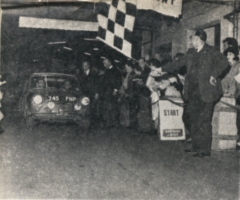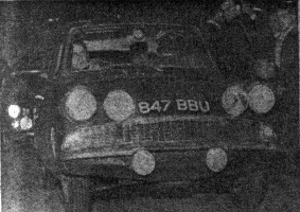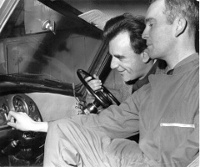MN Rally Championship - Round 4
TOP RALLY ?
WITHOUT any shadow of doubt, the Express and Star Rally organised by the Wolverhampton and South Staffordshire Car Club is one of the finest rallies currently held in these Islands and its reputation is such that it is almost achieving legendary proportions. Last year's event became the Rally of the Year for Ecurie Cod Fillet and the standard of the 1963 event was such that it may well take the same honours again this time. The Express and Star is a qualifying event in three rally championships, the R.A.C., the B.T.R.D.A. Gold Star and Motoring News, and thus a formidable entry of over 160 crews turned up from all parts of the British Isles to contest the victory. Apart from the usual selection of lads and lassies, there were one or two who had made a longer journey to compete and these included Bertie McElhinney and Ronnie McCartney / Terry Harryman from Ireland, and also Andrew Cowan and his navigator, B. Coyle, from Scotland: Tony Fisher and Brian finally took the honours with 14 minutes lost, which is an incredible record when the overall conditions and the tightness of the route are taken into account Unlucky for the second year running was David Seigle-Morris who, navigated by David Stone, lost the middle part of his exhaust system while leading the rally and just had to slow up in order to hear what the navigator was saying and, as this was at the toughest part of the route, he finished five minutes behind Tony.
Good organisation
The organisation was everywhere superb and it was, perhaps, shown at its best where the timing was concerned. This was naturally operated on the Express and Star system which, this year, had been refined by its inventor, Dr. Peter Carlyle, to the stage where a results sheet was handed to each competitor within a few minutes of clocking in at the finish.

This sheet showed exactly how much time the particular crew had lost and the whole set of results was announced, two minutes after the last year was officially due to finish. In fact, the whole thing was so smooth that the Clerk of the Course, Richard Binns, was at home before midday on the Sunday with the results finalised and the awards presented. There can he very few rally organisers who can claim to have achieved this.
The start was, as usual, in Wolverhampton and again things moved along smoothly. By nine o'clock, the first 40 cars were lined, up ready to go and the navigators of the early numbers were already drawing the detail of the route and starting to plot. The route was defined purely by map references with directions of approach and, wherever there might be any doubt as to the correct route between them, go-via references were given. Even then, there were a large number of arrows placed along the route so that the wrong slot might not be taken were the route was ambiguous or hard to find.
The first section was a 75 minute run-in to the top of Long Mynd, which enabled navigators to finish plotting and check the route. The first control was at 404½919, approach N.E., and while there was a choice of routes to the next control, the marshal at the first was instructed to tell competitors that the shorter route was impassable. It was certainly marked as a nongoer on most maps. The road up to control two (403930) was a good sample of what was, in store and this muddy road, covered with water from melted snow. could best be described as a good splash. The first sections were incredibly tight and by control five, the entire entry had lost at least one minute, and this was the deliberate intention of the organisers so that everyone would he at a psychological disadvantage right from the start.
Casualties
Pauline Mayman and Val Domleo had the misfortune to tear off part of the undertray of their M.G. 1100 on this very first section. It got caught under their exhaust and the ensuing mess prevented them from continuing. Another early casualty was. the Vitesse of Roy Fidler and John Hopwood, which came to a halt at control five with a hole in its distributor which was letting in large quantities of water. This was eventually repaired' with a piece of cardboard and tape and the Vitesse motored even better like this than it had before, but Roy was forced to cut five controls to get back in the rally, which thus assumed a mere academic interest for them.
Control five was at 399994½, approach S.W., and only the brave went fast on this section, which was downhill on very soggy grass three-ply, and no sooner had they recovered from this traumatic experience than they were hastening north on to 118 to Hobberley for a two minute section over to Snailbeach. The roads leading to this were terribly scarred where the frost had lifted the surface and the escaping water had washed the banks down on to the road. The two-minuter skirted a Prison Commissioners farm at Vessons and went through the maze of white roads to control seven at 373½4022½, approach S.E., and no one was as surprised as the navigator when the control was finally reached. The eventual winner, Tony Fisher, had lost three minutes by this control, as had John Sprinzel, but it is thought that David Seigle-Morris was a minute up or, hem at this point.
Linley hill
The route plunged back south off 118 down to the Bog and the classic sections over Linley Hill and then round Rhadley Hill to the intersection of the A488 and the A489 at Snead. There were then some slightly easier sections winding north again through Old Church Stoke, Fishpool and Priestweston before disappearing on to 118 for a loop on to 117.

"Slightly easier section" on the Express and Star does not indicate that there is time to take things easy, but just indicates that it should be possible to regain the 59 seconds that was lost while scraping into the previous control. One or two of these sections were particularly easy because some controls had had to be re-sited because of the conditions, and the old time cards were being used as the cost of new ones would have been prohibitive. The whole of this first part of the rally was exceptionally well thought out and quite a lot of new roads had been discovered, so that by control 20 (117/270050), the rally had not progressed more than 10 miles as the crow flies from its start point on the Long Mynd.
The road down to 21, just north-west of Kingswood, was particularly memorable as it contained several, humps which caused the cars to pitch violently as they hurried downhill. For the next part of the rally, the 1963 Targa route was much in evidence although it was hardly recognisable without the snow, which has disappeared very quickly indeed. Cyril Corbishley and Barry Potts had a narrow escape when they emerged a little hastily on to the A483 south of Welshpool, brushed a non-competing car and wound up in the ditch. They were not injured badly, but their little Standard Eight looked very sorry for itself.
Troubled halt
The route did not stay on 117 for very long and, following a section through Castle Fluke, it went to control 26 on 128 via 157000 and then through a series of short, fairly tight sections to the petrol halt in Tregynon. It was on this part of the first half that Phil Simister and Graham Robson lost the dynamo from their Allardette and they spent a busy time at the halt finding another dynamo and bracket and fitting them to the car so that they could continue. It was not strictly their car as Phil had blown up 12 NMA on the way to the start and had phoned back to Ron Wilson, who had brought his own car for Phil and Graham to use. Brian Harper and Ron Crellin were also working hard on their Sebring Sprite, which refused to charge the battery over about 4,000 r.p.m., and this eventually caused them to retire. John Sprinzel and John Davenport brought their Anglia into the halt fifteen minutes down after changing a wheel, which cost them five precious minutes, and within a couple of miles of setting off from the halt, the Sprinzel luck struck again when the sump plug unscrewed, the oil poured out and the big ends suffered badly. They were able to freewheel down a backroad to the halt again, where Dennis Thorne supplied sump plug, but the mere addition of oil and Molyslip was not enough to save the engine and they retired. After a brief spell on 117, the route turned south again towards Caersws and control 39 was located at 053962 app. N. which plotted just north of the yellow road junction. However, there was a metalled road off to the right just at the control and on the map it is obscured by the "y" of Llwydcoed so that it was quite easy to take this as being the yellow road to New House. Several people fell for this and Doug Ray/Tony Straker (Allardette) lost six minutes investigating it. Tony had a rough time of it on this part of the route for on the first of six consecutive two minuters around Mastre-gomer they found the Saab of John Grirmshaw stuck in the ford at 981930 and while rushing to push it out. Tony modified his upper lip and the river almost literally flowed with blood. From this scene of carnage, the route passed through Staylittle and on to 127 for the final fling along the Dylife road. Control 51 was at 8041985 app. SE with control 52 at 8023985 app. NW in four minutes and an intermediate reference indicated the use of the white road hidden amongst the contour lines north of the river. Brian Culcheth and Ted Cowell (Sebring Sprite) were pressing on along the yellow road when they came to the innocuous looking left-hander with a white road going straight on and discovered too late that the main road went sharply down to the left and took to the bank. They were so shocked at the final angle at which their car came to rest that it took them a good 20 minutes to extricate it and they were thus forced to cut 10 controls to get back in the rally. The route followed the general pattern of the London until it reached Talybont when the really new part of the rally commenced.
Dam road
Richard Binns had spent, a great deal of time persuading the Electricity Board that their roads deserved to be used by more than just lorries, and had eventually got permission to use a road round a dam in the general area of 7586. For what they are worth, the references of controls 60 and 61 were 736885 app. N. and 762½834 app NW. The dam itself was floodlit and Robin Richards suggested that so many people lost time on this section because they stopped to admire the awe-inspiring sight of this magnificent balk of concrete. From 61 to 62 the route lay through Ponterwyd and then north on the white road to Cwmsymlog and this section was the only one which brought complaints as there was an unmarked road going straight; on into a new quarry and the correct slot off to the left, although signposted, did not look like the route. In fact there was meant to be a direction arrow on this one but the sector marshal omitted to place it in position and a lot of crews explored the quarry as a result. One such was Mike Goddard and Rod Abbott (MG 1100) who lost nine minutes here and had to cut a couple of controls to get back in the rally.
Special test

The last sections south of Goginan proved to be rather too slippery and muddy and after one or two cars had passed through they became almost impassable and so that there should be no cause for protest, the organisers scrubbed the last two time controls. The rest of the rally comprised a longish run to a tie-deciding test at Pont ar Elan where Stan Annis presided in his capacity of chief marshal, and then another run to the finish at the Metropole in Llandrindod.
The speed with which the results were produced has already been described and certainly nothing but praise for the rally was heard at the finish except for a few jaded souls who maintained that it was too tight. Perhaps the thought for the week should be that if only there were 12 rallies a year like the Express and Star, then these would certainly be sufficient to keep the circus fully occupied as well as satisfied while 12 rallies a year like the Express and Star could not damage public relations to the same extent that the countless rallies do at present.
RESULTS
GeneraI Classifcation 1, A. T. Fsher/B. Melia. (Austin-Cooper) 14; 2, D.Siegle-Morris / D. Stone (Anglia) 19; 3, R. McBride/D. Barrow (Anglia) 22; 4, D. H. Ray/A. J. Straker (Allardette) 17; 5, C. C. Nesbit /J. Williams (MorrisCooper) 37; 6 R. N. Rickards/G. C. Davis (M.G.B.) 40; 7, A. W. Cowan/ B. C. Coyle (Rapier) 41;8, D. W. J. Thorne/J. D. Cameron (Anglia) 43; 9, M. Sutcliffe/T. W. Rowlands (Austin Mini) 43; 10, J. Anderton/M. Kempley (Allardette) 43; 11, J. la Trobe/ J. Chitty (VW) 44; 12, D. Bache/I. McLeod (Morris 1100) 47; 13, H. Jacoby/M. Milchreest (Triumph Spitfire) 54; 14, A C. Cook/M. Wood (Austin Mini) 1 fail, 39 mins.; 15, I, H. Terry/R. K. Davies (Allardette) 1 fail, 45 mins.
Non-experts: 1, D. Cotton/L. Putts_ (VW): 2, Dr. N, L. Edmond/A Parkin (Austin Mini) 3. J. Williams/C. A. Hooper (Morris-Cooper)
Class awards: - Production touring cars up to 850 c.c.: M. Sutcliffe (Austin Mini); 851 to 1,300 c.c.: A. T. Fisher (Austin-Cooper); 1,301 to 2,000 c.c.: D. Seigle-Morris (Anglia); Over 2,001 c.c. McEthinney (Zodiac). Grand touring up to 1,600 c.c. R. McBride (Anglia): over 1,600 c.c. R. N. Richard (M.G.B.) Fastest Special Test Time: B.G. Williams, 29.8secs.
